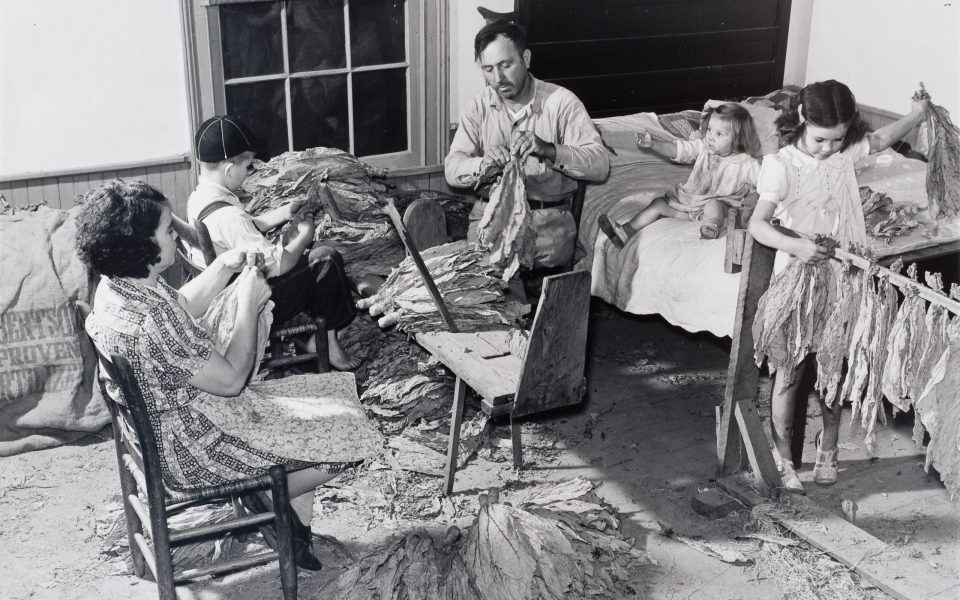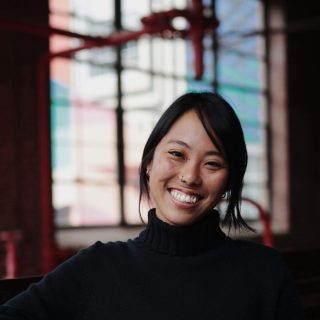The woman works carefully, hands gripping the utensil as she hunches over her workstation which has been prepped for making tortillas. Her jet-black hair is swept back into two tidy braids that disappear beneath a makeshift cocoon that’s strapped to her back where her child sleeps peacefully, their fist closed just next to their mouth. The mother’s lips are sealed in concentration and bags have formed under her eyes.
“Tortillera with Child (Rest and Work)” by Jean Charlot is one of several works of art that hangs in the upstairs gallery at the Weatherspoon Art Museum. The lithograph is displayed as part of an exhibit titled Ties that Bind, put together by Elaine Gustafson, the museum’s curator of collections.
“The works show relationships among family members,” Gustafson says. “And that is defined how anyone wants to define a family. There are some mother-child relationships, male-child relationships, siblings, self-identified families.”
The show, which opened in mid-September but had been planned months in advance, was almost serendipitous, Gustafson says, because of the way the pandemic has changed and emphasized relationships.
“One of the things about the pandemic is that we were all re-exploring, re-examining what relationships were important to us, which ones we missed, and how sometimes those relationships were driving us crazy because we didn’t have the outside resources,” Gustafson says. “So, this was just the perfect timing.”
In Charlot’s piece, the intimate bond between the mother and her child is at once obvious and familiar. Since the onset of the pandemic almost nine months ago, mothers across the world have stepped up in many ways within their households, from childcare to schooling to working. Within Charlot’s straightforward work, these assumed responsibilities of motherhood are on display as the unnamed woman works quietly and diligently to provide for herself and her child whom she protects and carries as she labors.
Nearby, in a black-and-white photograph by Marian Post Wolcott, captured in 1939, another domestic scene plays out across the frame. Titus Oakley’s family of five, including three young children, works together within the confines of a single bedroom stripping, tying and grading tobacco in Granville County. It’s the end of the Great Depression and the whole family works in tandem to survive. Like the pandemic that continues to rage on throughout this year, the decade of the ’30s was marked by hardship and strife. Gustafson says that it’s times like these that make one think carefully about relationships and what they mean to us.

Ties that Bind will be on display at the Weatherspoon Art Museum in Greensboro through Feb. 13. The museum is open Tuesdays through Saturdays from 10 a.m. to 5 p.m. Admission is free. Visit weatherspoonart.org for more information.
“People can think about these issues and what has happened with this pandemic and people losing their loved ones and not seeing their families,” Gustafson says. “I think a lot of people are thinking about relationships and what matter to them and mourning as well as celebrating.”
As the holidays fast approach, she says that these questions will become even more prescient. Rather than traveling up north to celebrate with her family as she usually does, Gustafon says she’ll stay in Greensboro with her daughter.
“It’s like, We’re going to spend the holidays just the two of us?” Gustafson asks.
In a second room, the curator turns the notion of the ties that bind on its head to look at relationships that might be struggling or are in conflict.
In a photograph by Nikki S. Lee titled “Part (37),” the artist has taken a picture of herself with a male companion but later crops him out of the frame so that only she is pictured fully. In the photograph, Lee sits on a mustard-cloth covered couch and rests her elbow and wrist easily on the cropped-out man’s right leg and looks directly out at the viewer. Her gaze is somewhat unfocused.
“There’s some fun elements to some of these where we don’t know what the narrative is and you can kind of project,” Gustafson says.
She says that while she wanted to show the intimate and closeness of certain relationships, she also wanted to explore the idea of relationships that may not serve us anymore.
“I just want people to be able to see a work and say, ‘Oh I get that,’ or, ‘That is reflecting of me and my situation,’ or ‘That brings me comfort,’” she says.
A large painting depicts a golden, lit-up apartment building where its inhabitants can be viewed in an almost voyeuristic fashion. In one room, a man and woman appear to be arguing based on the two figures’ body language while in another, a fun gathering is taking place. Each room acts as a separate scene from the last, a separate life, a separate relationship.
The title of the work, “Night Clouds,” by Roger Brown, alludes to the setting outside of the high-rise where large, billowy storm clouds have gathered and threaten to engulf the building. In the piece’s description, Gustafson writes that the clouds “serve as an allegorical backdrop for the larger physical and metaphysical forces that hinder the human endeavor.” And in this moment, in the midst of the pandemic, the painting seems to parallel our current reality.
“That’s exactly what I’m showing is the two opposite ends of the spectrum of the ties, the relationships, that bind us,” she explains. “It’s about the important relationships in our lives but also those that are due to isolation or even a mother and child that has grown separated or is strained or something like that, but they’re still tied. There will always been ties between those people.”
Join the First Amendment Society, a membership that goes directly to funding TCB‘s newsroom.
We believe that reporting can save the world.
The TCB First Amendment Society recognizes the vital role of a free, unfettered press with a bundling of local experiences designed to build community, and unique engagements with our newsroom that will help you understand, and shape, local journalism’s critical role in uplifting the people in our cities.
All revenue goes directly into the newsroom as reporters’ salaries and freelance commissions.


Leave a Reply